September 3rd, 2010 · 1 Comment
First, who’s not in the National Portrait Gallery? Minorities! Honestly, even without the prompt, it would have been a slow realization that as we walked through room after room of white faces, something was missing. There was one freed slave portrayed in the audience of an abolitionist convention, and that was about it as far as paintings of minorities at the Gallery go.
Second, and more broadly, working class people are not in there. This, to me, is less upsetting as it’s just a natural consequence of the fact that only the upper crust can afford to have portraits commissioned. Hours after visiting the Gallery, though, the lack of minorities still rankles, for one simple reason. If a black or Asian or Latino family came to visit the Gallery, and one of the children asked their parents “Why don’t any of these people look like us?” the parents would have no good answer.
____________________________________________________________________________________________
We were supposed to pick one portrait that we found particularly affecting. As a political science major who has taken British History 244, though, I could not resist going with the dueling portraits of William Ewart Gladstone and Benjamin Disraeli. Gladstone was the pillar of 19th century liberalism, while Disraeli was his counterpart on the right.
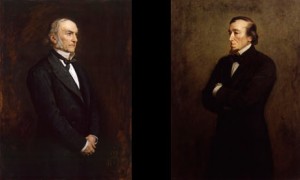
credit: youreader.com
This is exactly how the two portraits (by the same artist, Sir John Everett Millais) appear in the Gallery. In the Victorian era, the two were the titans of Parliament, serving as Prime Minister six times collectively. There is much, much more on their epic personal and political rivalry here:
http://www.bbc.co.uk/history/british/victorians/disraeli_gladstone_01.shtml
A favorite quote of mine on their lack of mutual respect, from Disraeli is “The difference between a misfortune and a calamity is this: If Gladstone fell into the Thames, it would be a misfortune. But if someone dragged him out again, that would be a calamity.”
Their respective portraits contain subtle and not so subtle bits of political imagery. First, Gladstone is facing to his left, while Disraeli is facing his right. The rest of what follows may be a bit of armchair psychology, but I believe it speaks volumes about both men.
– Gladstone has his hands folded, while Disraeli’s arms are folded in an aggressive posture. Disraeli was far more warlike as prime minister.
– Gladstone is looking towards the sky, while Disraeli’s gaze is a bit more earthward. This is in line with both men’s fundamental outlooks on life: Gladstone considered himself a great Christian moralist, while Disraeli preferred to concern himself with more earthly issues, considering Gladstone to be out of touch with the nitty-gritty of the world.
While the placing of these two portraits together obviously has an intended effect, that does not make the effect any less powerful. While standing in front of the two portraits, I felt like I could almost feel the hate flowing between these two great men, a great moment for a politics junkie like me.
Tags: 2010 Dennis · Museums
September 3rd, 2010 · 2 Comments
I think we can all agree that the National Portrait Gallery is filled with the white and wealthy. There were very few portraits of people of color, and even then they could only be found in the modern section. I found this was also true with portraits of women. Most of the the paintings seemed to feature men. As a woman, I found this both sad and frustrating. I was also disappointed by the fact that in the earliest collections of portraits almost every face looked the same. When I commented on this to Amy, she told me that at this time sitters would pose in order to look dignified, influential, and noble. This answers some of my question, but looking beyond the posing to the actual faces, I was still struck by the replication of features. It made me seriously question the legitimacy of each likeness. I wonder to what degree the artist might have altered the sitters actual appearance and if so, was it done for a reason?
The portrait I chose, Mrs Philip de László has a bit more personality. 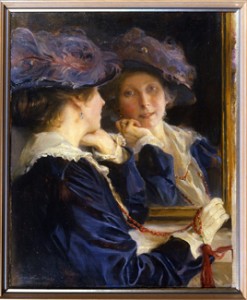 (Photo taken from the National Portrait Gallery, http://www.npg.org.uk/whatson/display/philip-de-laszlo.php)
(Photo taken from the National Portrait Gallery, http://www.npg.org.uk/whatson/display/philip-de-laszlo.php)
I picked this portrait because I simply just fell in love with it. I hadn’t ever heard of Philip de Laszlo before today, but my eye was immediately drawn to his collection which featured more women than some of the other artists. This portrait is of Lucy, his wife. I think the idea of painting both her actual body and her reflection adds some originality. It is certainly mush different than the stiff dignified portraits of the Tudors and Elizabethans. The portrait reminds me more of a candid photo. Her chin rests on the palm of her hand in a very relaxed but graceful manner. But I think it is her eyes that really make the painting. Instead of looking upon her own reflection in the mirror, her gaze is focused on her husband. This changes the tone of the painting into something much more intimate and warm. It brings much more life to the sitter than the repetitive blank faces of the first portraits we saw.
Tags: 2010 Sarah
September 3rd, 2010 · 1 Comment

Upon entering the National Portrait Gallery at its opening, I was struck by the immense size of the collection. For an art museum that had so narrow a focus, I was not expecting three full floors of work.
Beginning at the top floor, the museum took a chronological approach to the presentation of the portraits. One started going through rooms filled with portraits of the Tudors and ended observing portraits from the last decade on the bottom floor. The collection portrayed royalty, politicians, writers, musicians, artists, scientists, and other notable figures. Some of the artwork was surprisingly cynical in nature, while most were glorifications of their subjects. The term ‘national’ clearly was referring to the United Kingdom and not just England, given the presence of figures like James Joyce. Also, the collection seemed to feature figures that were mainly associated with the UK, as Handel was featured despite the fact he was born, and grew up, in Germany. A clear emphasis was placed on the rich and famous, while relatively none of the works portrayed the lower classes. Also, no one associated with the British Empire, such as Gandhi, was included.
The portrait I decided to focus on was that of Sir Francis Drake, located on the second floor. As we were not allowed to take pictures in the museum, I have provided a link here: http://www.npg.org.uk/collections/search/portrait/mw01932/Sir-Francis-Drake?search=ss&firstRun=true&sText=sir+francis+drake&LinkID=mp01357&role=sit&rNo=o
The painting of the famous navigator is not particularly flattering or, quite frankly, well painted. He stands before the observers at an odd angle, holding an oddly (aka poorly) shaped globe resting on a table for balance. Drake is dressed in a garish pink outfit, with a cape that looks too stiff too be real. His arms appear to be different sizes, and legs appear to be much larger than his torso. Looking at his face, his cheeks appear to be inflated, making him look more like a comical figure than the daring naval admiral and pirate that he was. He stands with a slight arrogant look, as if ready to take over the world (something his nation would effectively try to do in the coming decades). Looking at the portrait, it is hard to get over the poor quality of the painting. With the dismal proportions, poor color scheme, and lack of inspiration, you would almost wonder if the artist is unknown because he or she was ashamed of the work.
I picked this painting because I was so struck by its poor quality, particularly in relation to many of the other works in the National Portrait Gallery. One could almost see the work as an accidental representation of the British Empire’s colonial overreach. With the country moving so quickly to expand, one can understand the rush to make heroes out of these new explorers, evident in this portrait of Sir Francis Drake. Unfortunately, just as the Empire was built on a weak moral foundation, the picture falls victim to poor artistry. Therefore, one could read the portrait as a representation of the weaknesses of imperialism… or one can just see it as a really bad painting.
Tags: 2010 Andrew
Upon departure from our safe haven at the Arran House, we attempted to navigate the streets of London to no avail. While aimlessly wandering, we stumbled upon such landmarks as the British Museum and the University of London, essentially touring the greater London area for a thorough hour. After questioning a few pedestrians and going in the wrong direction on more than one occasion, eventually we made it to the Euston Square Tube Station. We boarded the train and set out for the Barbican stop located on the Metropolitan Line.
The name Barbican was chosen for the train station in 1968 as an alternative to the former name of “Aldersgate”, renamed for the famous Barbican Centre, the largest performing arts centre in all of Europe.
The general feeling of the Barbican area of London was a sophisticated, high class, multi faceted slice of society in which the arts and business thrive. We visited the Barbican Centre, a beautiful achievement in the arts (among them, surrealistic modern art, dance, music, and theater). We briefly viewed an exhibit that was on display courtesy of John Bock. In the back of the Centre was a great fountain display accompanied by hipsters and coffee shop-goers lined with elegant churchlike buildings from the days of old. When we made our way further towards the Business and Commercial area of Barbican, we found many towering, glass company buildings. Even further down the road we encountered many shops before we embarked on the journey home via the Tube.
On the way back we enjoyed a scrumptious local Italian-ish dinner at a restaurant near the Euston train station. After the meal, we hopped back on the train and took the Northern Line of the Tube from the Euston station to the Goodge St. station, and returned safely home to the Arran House (in the pouring rain).
Tags: 2010 Benjamin · 2010 Rachel
Fractal Contemporary Gallery is located on St. Giles Street, a few blocks from Norwich City Hall. When I walked in I was immediately reminded of my Aunt Leslie and Uncle Barry’s old house in Richmond. Why? Because I always got the same feeling of awe when I stepped into their main sitting room. The walls were covered in surrealist and abstract art and the way the light filtered into the room just gave everything a clean, soft white glow. The art that covers the walls in Fractal Contemporary is nothing like my Uncle Barry’s collection, but the light is the same, and the soft carpet reminds me of a family room. I immediately felt welcome there. I knew I would have a good experience working with this gallery. I couldn’t have been more right. Ms. Lisa Thurlow is the owner and director of the gallery. Fractal Contemporary has been open for just under two years and while the recession did have some impact on the business, the profits are once again on the rise. Through my interviews with Ms. Thurlow, I gained a great deal of insight into how a small independent gallery operates and where she finds her artists. Usually she travels around to University degree shows and open studio events. She also subscribes to the Art of England magazine. This way she not only finds local Norfolk artists, but artists from all around the world. As a result the art in her gallery is incredibly varied, the gallery sells an eclectic array of art including, paintings, drawings, sculpture, jewelry and even some knitwear. As I would soon find out, working in a gallery requires a lot of patience. Most people that walk in will not buy anything, but the fact that they made the effort to come in and look around gives the hope that they might be back. And as I have learned from my research, the job of the dealer is to help match people with the art. Mrs. Thurlow lets her potential customers have their space and look around before she steps in to negotiate a sale. She only ‘swoops in’ when she overhears the potential customers discussing price of if they ask her a question. This business is all about reading people, their body language and a little bit of eavesdropping. In her own words, “one has to be a bit ‘hawk-like’ and be aware of what people are looking for.” People watching? Art? Sign me up. Most of her business is from people who walk in off the street, so her welcoming window display and friendly atmosphere are working to her advantage. Whilst the gallery does have a few collectors, most of her energy is devoted to cultivating new relationships with the people who come into the gallery and her artists. Unlike many dealers, who put on a façade of non-commercial self-representation, I truly believe that Ms. Thurlow is more concerned with the people rather than the money. Of course she wants to sell the art and make a profit, but I think she is in this business because she loves what she does and she loves the people who she meets by selling fine art. I have learned so much by talking to Lisa Thurlow, and I hope we are able to stay in touch even after I leave Norwich.
Tags: Grace
I had hoped that my interview experience with Mandell’s Gallery on Elm Hill would make up for Mr. Mandell’s poor email correspondence… it didn’t. I began to email and call the gallery after another art dealer that I should go and ask a few questions about the gallery suggested it to me. The first time I went into the gallery (around March), I told Mr. Mandell my name and about my research paper. He seemed interested enough, but said he didn’t have time for an interview at the moment. I told him that was fine (I know his business comes first) and that I would email him the questionnaire so he could fill things out at his earliest convenience. After a few weeks I began to email again, no response. I called to make sure I had the right email address. The woman on the line told me the Gallery was about to open a show of John Kiki’s works and that Mr. Mandell would be more available after the opening…. OK, so I wouldn’t have the interview until after the first draft of my paper was due. OK, not going to panic. After a week and still no response (email or otherwise) I decided to go into the gallery to see if I could get some answers. The way I was raised, this kind of behavior is unacceptable. If you receive email or a call, at least have the decency to respond…even if it’s just to say you’re too busy and to give a date when you WILL be available. Well, after I reintroduced myself to Mr. Mandell he kind of gave me the ‘I think I remember you, but I’m just not quite sure’ kind of look and then searched his inbox for my email. “Ah, yes” he said, “yes, I don’t really feel comfortable answering some of these questions…I think they are a bit leading” Alright, how does one respond to that? I’m sorry? I didn’t think my questions were that leading….just enquiring about the general policies of the gallery and what kind of people buy their art. Apparently Mr. Mandell’s competition is hot for him right now and they will do ANYTHING to learn his secrets. I was a bit taken aback, and although I assured him my research was purely academic, he was still unwilling to answer any questions about how he prices his art or what kind of client he markets for. Mr. Mandell, if you’re reading this, I’m sorry, but I really don’t think you have any reason to worry…I am NOT going to spill any sort of insider gallery dealer secrets. I think you are probably a nice guy, especially after you told me you used to vent your jeans in the 60s to make them flare out…it’s cool, it was the 60s after all. Anyway…back to the point. While this interview was not as helpful on the specifics of buying art in Norwich, he did have some opinions on the general culture in Norwich. Essentially, Norwich has always been a bit of a hot spot for the arts…the only problem? Geographical isolation. However, this isolation made the arts in Norwich a priority as the people would have hardly been able to travel to London to see a play or a painting. Norwich has always had a thriving theatre (the first being the Maddermarket Theatre) and the Norwich School artists are probably the area’s most famous visual artists. Even today, the Norfolk and Norwich Contemporary Art Circle, the Playhouse Theatre and the city’s recent bid to become a UK ‘City of Culture’ keep this arts-rich area a cultural meeting place. Despite the provincial setting, the isolation has kept the art world in Norwich centered on Norwich. And with so many galleries opening in the last fifteen years, the people in this area still don’t have to travel down to London to acquire great art. Right now, I’d say the traditional subject matter of landscape and portraiture are still outselling the more abstract contemporary pieces, but the contemporary arts are on the rise. The trends in art (and other areas) will come and go, but Norwich will always remain a city of the arts.
Tags: Grace
Horace Blue Gallery is on Lower Goat Lane (which also happens to be my favourite street in all of Norwich) and I can remember passing by a few times first semester and wondering what might be hidden behind all the funky graffiti and funny cartoon faces. In December I got my first chance. Unfortunately, the owner was not around. But I was able to browse the two tiny rooms of the gallery, which was filled with contemporary art from floor to ceiling. The first thing I noticed about the art was the incredible variety. This place had everything from painting to pottery, and all sorts of crazy mixed media pieces on display in a cabinet at the back of the first room. After obtaining a business card from the woman who was looking after the gallery in the owner’s absence, I was able to get in touch with Mr. Keith Webber. Keith is an architect who also happens to run the Horace Blue Gallery. He is currently in Jersey working on a project, so all of my correspondence with him was by email. After a the first few emails back and forth I sent Keith a questionnaire about the way he runs his gallery, the kinds of clients he markets for and other market related topics. I was hoping to receive more of an up beat response after the last word I had heard from him about the Norwich art market (see my previous post for more details). Horace Blue Gallery is more avant-garde than the other establishments I have been in contact with, so I wasn’t too surprised by his answers (just a little disappointed in Norwich). The work in his gallery is mostly by friends of his, or artists he has met through his network of friends. Currently he has about fifty artists that have shown at the gallery. Like the other owners I have interviewed, Keith tended to go for the ‘nice guy’ approach when it concerns potential buyers. He claims he is not willing to cultivate a false relationship just to make a sale, especially if that client becomes a collector… “if I don’t like someone I’m not going to have any sort of relationship with them, so the few collectors I know, I have become friends with.” From my research into the world of the art gallery, this sort of statement is commonplace for small gallery owners who would rather be your friend that your supplier of fine art. Hopefully…eventually that friendship will blossom into a regular sale for the gallery. Unfortunately for Keith, it seems he made the wrong sort of friends (financially, that is). In his own words,
“I show work I like. Maybe that’s why it hasn’t been a financial success. So the people I attract were people who shared my tastes…which is great, because you immediately have something in common with people who come in. I’ve made so many friends by having the gallery. I would have liked it if the people that came in had the money to buy what I was showing. I think the people who have money in Norfolk are older more traditional people, so their taste didn’t match mine.”
As much as Norwich is a city full of young culture and arts, with the UEA Sainsbury Centre, the Contemporary Arts Festival and the Norwich University College of the Arts it seems the gallery could not survive on support alone. As far as my research extends, most of the wealthier art buyers have more traditional taste and Horace Blue has become a victim of this statistic. I think that’s a real shame, because the artists at this gallery are from all over the UK and don’t seem to play into the generally fetishized market that emanates from London and also does not want to conform to the norm for provincial Norfolk. So I am left with the fact that this great little gallery will probably go under and Keith has once again managed to make me question what the art market is all about… how can the people of Norwich let this hip, young and quirky little gallery close up? SAVE HORACE BLUE!
Tags: Grace
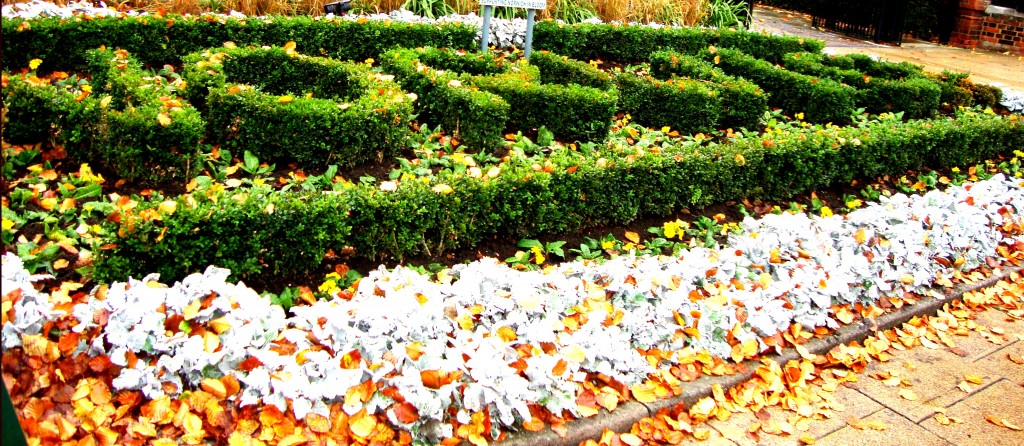
Before I came to Norwich, I expected it to be a small town with not much to offer a big city girl like me. As an English major and art minor, I have always been interested in the arts. But in New York, and even sometimes at Dickinson, arts events like small music gigs or poetry readings are all kept in a need-to-know or who-you-know circle. When I first arrived in Norwich one of the first few ‘local’ people I met was Stephanie Leal, one of our tours guides for the tour of Norwich. As a published poet, Stephanie told me and a few of my literary friends about the monthly poetry readings at the pub the Birdcage. I went to one of these within my first month here and loved it. As cliché as it sounds, I found being surround by so much creativity and talent really inspiring for my own artistic pursuits.
When it came time to choose something as my ‘Experience’ in Norwich, it wasn’t hard for me to pick out my interests. I knew the Birdcage was great and wanted to pursue the poetry/arts scene in Norwich. But it wasn’t until I began spending time researching and making connections here that I realized how huge the arts scene in Norwich really is. Now, you may be thinking, New York City must have a big arts scene, bigger than Norwich! And while that may be true, it’s hard to make connections with ‘local’ poets in New York. By the time most people get to New York, they are already up-and-coming. Tickets sell out fast, most of the good arts scene is underground, and you have to know how to look for it. And honestly I don’t. But in Norwich few events sell out too quickly and even well known successful poets, like the members of Aisle 16, have time to chat with a uni student like me.
Following the performing arts scene in Norwich led me to discover the Norwich Arts Centre, which holds concerts and various music shows as well as some art exhibits, and the live music at the Black Horse Pub during March. I also got to spend more time at the Birdcage readings. There were also more events and venues I just didn’t have the time to attend. There are various concerts held at the Waterfront and prose and poetry readings at Jurnet’s Bar Wensum Lodge from October to March as part of a series called Café Writers. Art is bursting from Norwich, all you have to do is look.
Besides attending all these great events, my project taught me to appreciate a lot more live music than I used to. I learned that artists of all kind are people who are accessible and want to share their experiences. Through my interview with Aisle 16 I found out about the differences between performance and printed poetry. Several of the members of Aisle 16 graduated from UEA. I began to realize that artists aren’t born out of a vacuum with the ability to create beautiful and moving works. Instead, artists are people who went to school, met up, shared passions, and created together. My exploration of Norwich arts help to inspire me in my own artistic endeavors. Here at UEA, back at Dickinson College, and at home in New York, opportunities are there, people are interested, and creativity can be found all around—even in a small town like Norwich.
Tags: Megan
In the beginning, before WWI…there was Fionn Regan. My flatmates and I went to see Fionn Regan at the Norwich Arts Centre on February 25. The crowd, as my flatmate noted, was made up of mostly “artsy 20-somethings.” Regan has released two albums and five EPs. Unfamiliar with Regan ahead of time, I found it hard to distinguish the lyrics of his indie folk songs—especially with his Irish accent. The gig opened with the up and coming band Danny and the Champions of the World, who also acted as backup band for Regan later on. All the members of the Champions wore plaid shirts and were vaguely reminiscent of New York hipsters. My favorite by far was the drummer, who wore black thick rimmed glasses. Despite their lack of fan base in the audience, the crowd took to the band immediately. Their upbeat songs and catchy lyrics were easy for us to pick up. The addition of acoustic pieces along with these faster songs kept us all engaged. The Champions successfully built up the excitement for the main act: Fionn Regan.
When Regan finally took the stage, I have to say I was a little surprised. Also decked out in plaid, Regan wore a collarless shirt with a silver beaded necklace. He donned an old-school mushroom hair style and kept his mouth right on the microphone—adding to my inability to distinguish his words. However, his fans in the audience had no difficultly singing along—except my flatmate who apparently doesn’t sing at gigs. The crowd cheer at every one of Regan’s lyrics. And as one of his final songs, his best known single from 2006, Regan turned the mic off and let the crowd fill in the chorus, “Be good or be gone.” I have to admit, this last song did move me a little. I always enjoy being part of the crowd’s energy.
Overall, I wouldn’t say that I am a converted Fionn Regan fan, but Regan is just another example of the eclectic music scene in Norwich!
Hours: 2.5
Total Hours: 8
Tags: Megan
September 15th, 2009 · No Comments
-
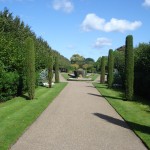
-
Regents Park
-
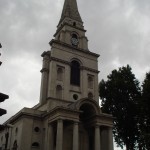
-
Christ’s Church
-
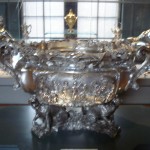
-
The Silver Exhibit in the V&A
-
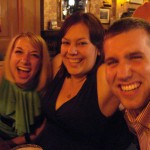
-
Having a Good Time at the Fitzroy
Like many of my classmates I decided it would be worthwhile to summarize all of my discoveries this month in London. During this post I will focus on six main themes found within London: Parks, Churches, Pubs, Other Religious Institutions, Theatre and Museums.
Parks
Each park that I visited had its own distinct characteristics that separated it from any other. Green Park was the first I visited and after perusing a few others, I realized there was nothing that exciting about it. Located right across from Buckingham Palace, Green Park certainly provides a good place to go and take a break from the busy atmosphere of the area. Besides this however there is not much going on and I would recommend that potential park goers walk the extra distance over to St. James Park.
In addition to the large number of waterfowl heckling people for food which offers consistent entertainment St. James offers some picturesque flower beds throughout and various monuments along the way. It has the relaxing atmosphere of Green Park with a bit more excitement sprinkled in.
Regents Park offers a completely different feel from Green or St. James. Located in a separate area of London, Regents Park has a history of being used by a higher end crowd. I could tell this immediately from the feel of the park. The decorative shrubbery and elegant architecture throughout gave me a feeling that Regents is not as well used as other parks.
Since I was one of the members of the Parks group that gave a walking tour of Hyde Park and Kensington Gardens I could go into a lot more detail about these two green spaces but I will choose not to in an effort to be concise. In summary Hyde Park is the largest green space in London and is often used for larger events such as concerts, festivals etc. It also contains a large number of monuments throughout including the 7/7 memorial and the Diana Memorial Fountain. Kensington Gardens is home to a variety of key monuments but is not as well trodden as Hyde. Overall it makes for a quieter atmosphere, more conducive fo reading or “snogging”.
Regents Park were my two favorite green spaces in London. Regents, is both beautiful, and extremely large and I continually felt the need to go back and explore. Kensington Gardens appealed to me in that it was quainter than Hyde Park but contained a like amount of history and monuments throughout. Although I would be content spending a length of time in any London green space Regents and Kensington would be my top choices.
Theatre
Overall I enjoyed going to the theatre on so many occasions. What better place to do so than in London after all? Here I will discuss my favorite performances and theatre venues.
All in all I enjoyed all but two of the performances we saw. The two Shakespeare productions at The Globe Theatre were fantastic. Although I did not particularly enjoy reading Troilus and Cressida it made a huge difference to be there so close to the actors. The fantastic drum chorus at the end really sealed the deal. As You Like It was probably my favorite show I saw here in London. Although it is one of Shakespeare’s simpler plays the actors really made it jump off the page. Being down it the pit was fantastic because of all the ad-libbing and constant interaction with the crowd. I even felt traces of Touchstone’s saliva on my arm at one point.
The other Shakespeare performance I saw, All’s Well That Ends Well, was lackluster. Although the Olivier was my favorite performing venue (this is what an auditorium style theatre should be like…why can’t Dickinson have something like this?) the play itself was odd and ended on an abrupt and odd note.
The other play we saw at the National Theatre, The Pitmen Painters, was fantastic. Although I was dozing a bit because of the Benadryl I took right before the show, the actors kept my attention and I appreciated that the play was based off of a true story.
Easily the oddest play we saw was Arcadia. An extremely intelligent performance the play juxtaposed two different periods in time and created a singular storyline in which the plot was based. Overall it was an entertaining performance that made me think early and often.
Finally there was Blood Brothers. The lone musical I saw produced feelings of disbelief, anguish and held back laughter. The ridiculous 80’s sound track and creepy narrator just didn’t do it for me. I think it’s safe to say that I was not the only one from Humanities 309 who was a bit surprised to see just about everyone in the audience give it a standing ovation.
I had a very positive experience with the theatre here. I would go back to the globe again and again. I loved being that close to the action. I would also enjoy seeing another show in the Olivier. There really is so much to choose from here. It’s simply a matter of figuring out your tastes and saving your money so you can see a lot of performances.
Churches
From Westminster Abbey to St. Paul’s Cathedral we saw most of the major churches/cathedrals during our month in London. St. Paul’s was easily my favorite. From the fantastic crypt to the hundreds of stairs up to the tower it had so much to offer in the way of history and mystique. Westminster Abbey fascinated me primarily because of all the literary figures that had been buried inside as well as the room that was dedicated to “The Order of the Bath”. Other churches that I really enjoyed taking a look at were: “St. Martin in the Fields” which sits just outside Trafalgar Square and Nicholas Hawkesmoore’s “Christ’s Church” which is located in very close proximity to Brick Lane.
Other Religious Institutions
Overall the Sikh Gurdwara was my favorite place that we visited. I appreciated the simplicity of the religious doctrine as well as the conviction and honesty with which our tour guide, Mr. Singh spoke. The morning was capped off with a fantastic sit down meal together in which everyone was served the same food and drink.
I had different feelings about the Hindu Mandir. It was clear to me from the very beginning that the Hindu religion is not nearly as modest as Sikhism nor are they trying to be. From the extremely decorative prayer room, to the museum located right in the center of the Mandir I never felt particularly comfortable inside.
The only religious institution I wish we had gotten a chance to visit is a Mosque. I had been to one many years ago but I did not remember a whole lot from my experience. I wonder how much more lively the East End, and all parts of London would be if Ramadan were not taking place during our time here.
Museums
I could go on and on about museums so I will attempt to stay as concise as possible.
The British Museum was massive, convenient since it was so close to the Arran House but a little one dimensional at times. One of my favorite exhibits at the British Museum was a special exhibit on Living and Dying that drew information from all different time periods and cultures.
The National Gallery was fantastic. Although I have a hard time appreciating some visual art the gallery kept my attention for a number of hours. Seeing so many famous works of art was phenomenal.
The Tate Modern was my least favorite museum here. Although I am trying I have a hard time understanding modern art. After about 45 minutes in this museum it ended up being too much for me.
The Cabinet War Rooms/Churchill Museum were two of my favorites. The realization that I was standing in one of the most important places in World War II history was unbelievable. The War Rooms felt so authentic. I really felt as though I had been taken back in time to the 1940’s while inside.
The Victoria and Albert was easily my favorite museum in London. There was so much variety inside and so much to see. I could have easily spent a few days inside. Two of my favorite exhibits were the silver and jewelry exhibits. I’m not sure what this says about me as a person but I found it unbelievable that individuals could even own such treasures. I also enjoyed the laid back atmosphere of the V&A staff. At most of the other museums I visited I felt like I was doing them a disservice simply by being there. Although I understand that taking pictures of an object in a museum doesn’t do it justice I like to be able to have the option of doing so.
The Sir John Soane museum interested me but it wasn’t really my cup of tea in the end. It also had a stuffy atmosphere to it that I didn’t really appreciate.
One thing I can draw from my experience at museums here is that each and every one has something that distinguishes it. With so many museums I thought that it would be impossible to avoid some overlap but I never really felt that. Cheers to London and its museums.
Pubs
Finally we have pubs. What would London be without it’s public houses? In some cases pubs are the true museums of London, designating what an area was like in the past and what type of clientele it attracted. During my month here I had a chance to visit a few pubs and get a general sense of what some possible differences could be. It is clear to me that each pub brings something different and unique to the table. The Marlborough Arms was convenient being so close to the Arran House and was a great place to enjoy a pint over a meal with friends. The Court was conducive to socializing in a different way. The music was louder, the people louder and the drinks cheaper. Other places I visited offered other things that made them stand out as well. One thing that i’ve learned about pubs is that it’s hard for one to please everyone. Since everyone has different tastes and desires when it comes to pubs you are better off going to one with a small cohesive group.
To conclude this novel I would just like to say that I think we saw a lot of different faces of London this month. I realize there is much more to see here but between walking tours throughout the city, trips to major monuments and museums and individual exploration I have learned a ton about London, it’s history and where it is going. I look forward to more London explorations in the future but for now, ON TO NORWICH!
Tags: Churches and Cathedrals · Henry · Pubs · Theatre








